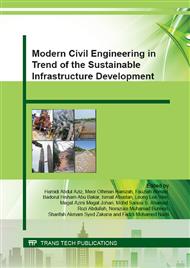p.543
p.549
p.557
p.563
p.569
p.575
p.581
p.587
p.593
Modelling Critical Period of a Reservoir System Using Performance Indices in Johor Catchment
Abstract:
Modeling the duration of the critical period (CP) and hence the precise mode of behavior of a reservoir system prior to analysis is advantageous because then the input data interval can be selected to match the requirement. In this sense, over-year systems (CP > 1 year) can be adequately analyzed using annual time-series data, whereas for within-year systems (CP < 1 year), only the critical 12 months in the data record are needed to be considered. The current standard demand parameter method for prediction of the behavior of reservoirs is based only on demand and coefficient of variation of annual flows. However, performance measures such as reliability and vulnerability are also important in the critical period of reservoir systems. Hence, the objective of this study, is to develop a predictive relationship for critical period involving standard demand parameter and both reliability and vulnerability performance indices as for use during the reservoir planning stage. The Johor catchment was selected as the case study. The reservoir was analyzed using a Monte Carlo simulation technique by modified SPA. The critical period prediction model was then calibrated based on the simulation results. Subsequently, the performance of the model was observed by comparing the model’s results with simulation outcomes for study systems. It was found that the performance of the model was very good in reproducing the critical period. In conclusion, it is promising given that this is the first equation to model critical period involving performance measures in Johor catchment as best of the authors’ knowledge.
Info:
Periodical:
Pages:
569-574
Citation:
Online since:
October 2015
Authors:
Price:
Сopyright:
© 2015 Trans Tech Publications Ltd. All Rights Reserved
Share:
Citation:


